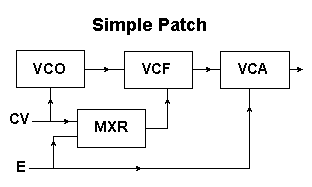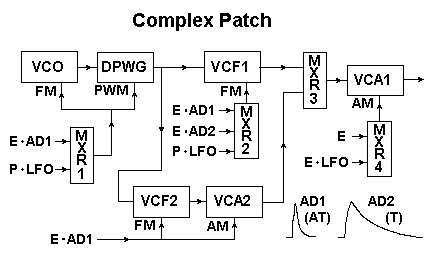Wind Control of Modular Subtractive Synthesis
Used with modular synthesizers, wind control plays a similar role to the usual ADSR (attack, decay, sustain, release) envelope generators employed under keyboard control. The patch shown below illustrates this idea. The input signals from the controller are 1) "CV", the one-octave per volt main control voltage and 2) "E", the wind or breath envelope control voltage. The frequency-control input of the voltage controlled oscillator (VCO) is connected (or "patched") to CV, producing musical pitches corresponding to the fingering of the controller. The amplitude-control input of the voltage controlled amplifier (VCA) is patched to E, producing a signal amplitude -- or musical volume -- proportional to the blowing force.
The input signals from the controller are 1) "CV", the one-octave per volt main control voltage and 2) "E", the wind or breath envelope control voltage. The frequency-control input of the voltage controlled oscillator (VCO) is connected (or "patched") to CV, producing musical pitches corresponding to the fingering of the controller. The amplitude-control input of the voltage controlled amplifier (VCA) is patched to E, producing a signal amplitude -- or musical volume -- proportional to the blowing force.The voltage controlled filter (VCF) provides musical timbral changes in response to a mixture of E and CV. For example, the tone may become brighter as the breath pressure increases. Also, the filter cutoff frequency may follow the pitch control at less than one octave per volt, to prevent the high notes from being too shrill.
While a minimal patch such as this can produce reasonably expressive musical results, it can't produce the "bite" heard in the attack of traditional acoustic wind instruments. This is because the breath envelope from the controller merely follows the blowing force from the player's mouth -- there is no special transient phase corresponding to the buildup of acoustic energy in the wind column of an acoustic instrument. Another way to say this is that the mouthpiece controller does not produce a signal corresponding to the AD portion of the familiar ADSR envelope. In traditional synthesis technique, the AD portion of the envelope produces an initial transient -- for example by momentarily increasing a filter cutoff frequency, adding chirp to an oscillator, etc.
The transient phases of instrumental sounds are of crucial importance -- in fact, they provide the cues that allow us to differentiate among the sounds produced by individual instruments. Therefore, it is necessary to go beyond the simple patch above to implement musically interesting wind synthesis. To do this, I developed an approach combining wind control with AD transients generated and controlled by the wind controller.
To begin, it is important to differentiate between two major important types of transients. First, there are transients induced by the articulation of a new note -- for example by tonguing on a wind instrument or bowing on a string instrument. Second, there are transients between slurred notes, which are consequent to the establishment of a new vibrational mode in the instrument. This second type of transient is often ignored, but I have found it quite important to incorporate it in the production of interesting sounds.
My wind controllers have all incorporated a means to generate two separate trigger signals. One trigger circuit produces a trigger pulse -- denoted as "T" -- whenever a new note is tongued, i.e., every time the breath envelope E crosses a small threshold level. The second trigger circuit produces a pulse -- denoted as "AT" (for "automatic trigger") -- every time a fingering change occurs, as well as every time a note is tongued. These triggers fire separate envelope generators, usually denoted as AD1 and AD2, which can be incorporated into the synthesizer patch along with the wind control provided by E.
The usefulness of the AD envelopes can be enhanced by modulating their amplitude with the breath envelope. In my system this is done with dedicated multipliers that produce signals denoted as E x AD. The resultant initial transient envelope is weak when the player blows gradually into a note, and becomes more pronounced when the note is attacked sharply.
The figure below is an illustrative example of a more evolved patch incorporating some of the above ideas. This patch uses the control signals E and CV as in the previous figure (CV is not explicitly shown), and additionally four dedicated, derived control signals: E x AD1, E x AD2, E x LFO and P x LFO. Here, "LFO" represents a low frequency oscillator used for producing vibrato and tremolo, and "P" represents the control voltage from the pressure plate described in the "Wind Controller" section.

The sound source in this patch is a sawtooth VCO coupled to a double-pulse waveform generator (DPWG), which produces two pulses per waveform cycle. The frequency and pulse width of this combination are modulated by a mixture of E x AD1 and P x LFO, which produces a combination of chirp, chiff, vibrato and "timbre vibrato". The resultant signal is processed in two parallel paths. The first path goes through VCF2 and VCA2, both controlled by E x AD1, and represents the automatically triggered transients between slurred notes. The second path goes through VCF2 where the tonguing transients (E x AD2) are incorporated into the main sustained sound. The two paths are recombined at the input of the final VCA, which is controlled by the breath envelope E with some additional tremolo provided by E x LFO. This patch can produce complex reedy sounds, even a sound approaching an oboe.
Inventory
The following is an inventory of the modules in my hybrid system.
- 2 VCOs (SSM2033)
- 1 VC DPWG
- 1 State-variable VCF (SSM2040)
- 1 Four-pole resonant VCF (SSM2044)
- 2 VCAs (SSM2022 and LM13600)
- 1 LFO (CEM3340)
- 2 VC AD envelope generators (SSM2056)
- 1 Control-voltage processor (SSM2022)
- 7 VC mixers (SSM2022)
Demos
The following are examples of MP3 recordings made with my wind controller and synthesizer.
Telemann: An excerpt from the C-Minor Trio Sonata, first movement.
D. Scarlatti: The Keyboard Sonata L391.
Back Home